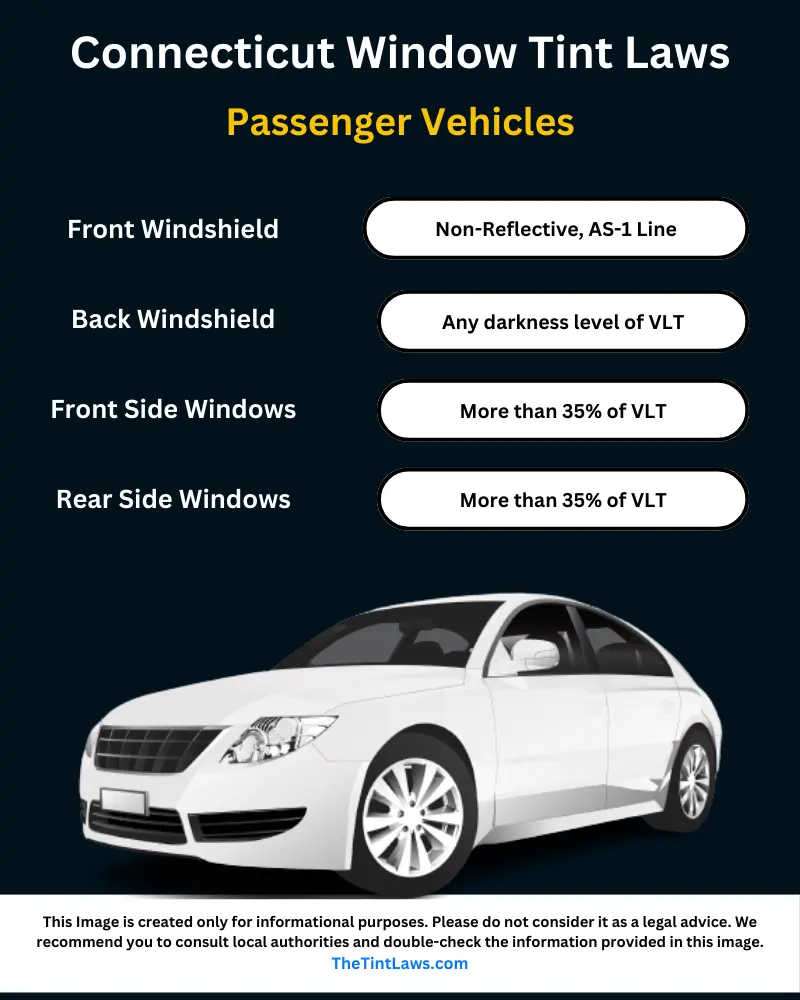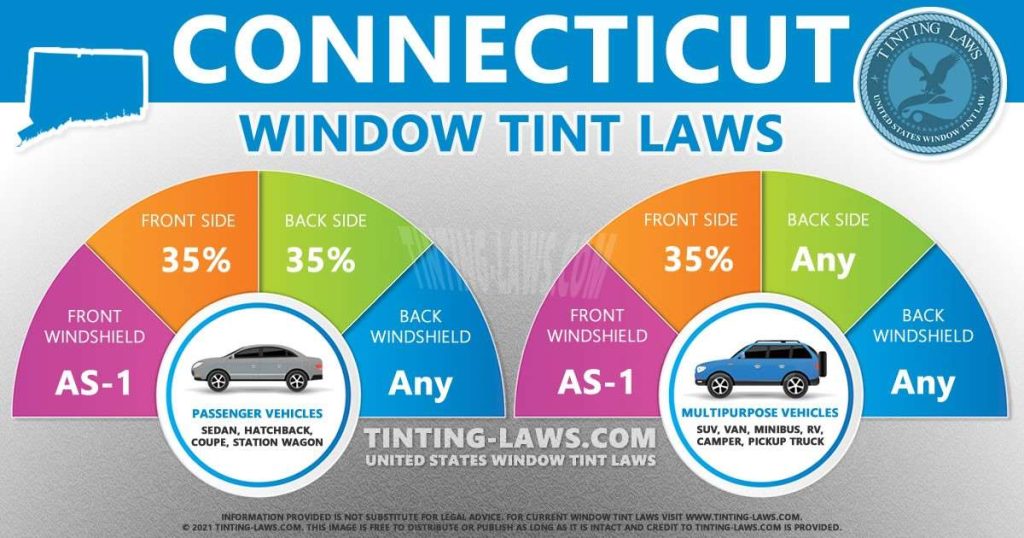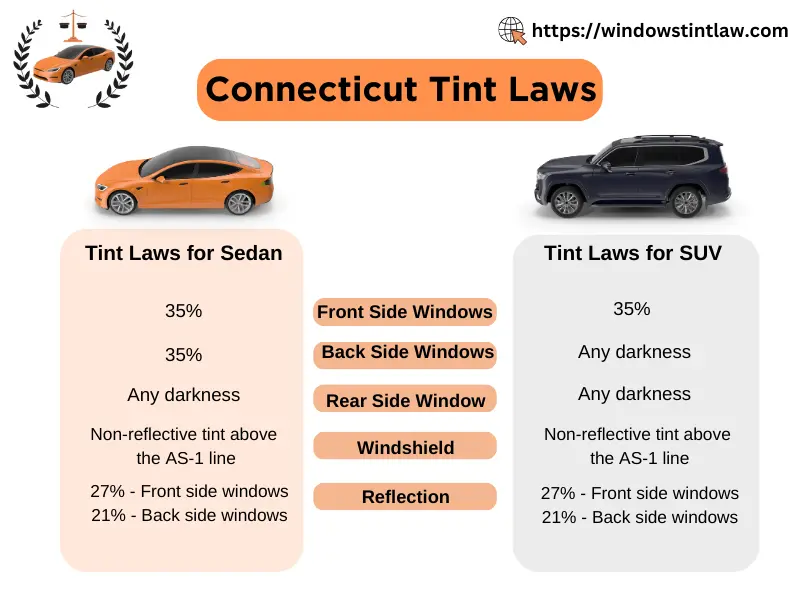Are you considering tinting your car windows in Connecticut? Before you make any decisions, it’s crucial to understand the Connecticut Tint Law.
This law dictates the level of tint you can legally apply to your vehicle’s windows, and knowing these details can save you from potential fines and hassle. You might be wondering why this matters to you. Well, imagine cruising down the road, enjoying the privacy and comfort that tinted windows provide, only to be pulled over because they’re too dark.
Understanding the Connecticut Tint Law not only helps you avoid unnecessary trouble but also ensures your safety and compliance with state regulations. Dive into this article to discover everything you need to know about window tinting laws in Connecticut and how they impact your driving experience.

Credit: thetintlaws.com
Tint Law Basics
Understanding the Connecticut Tint Law is crucial for vehicle owners. Tinting windows can enhance privacy and comfort. But knowing the legal limits is essential to avoid penalties. The Connecticut Tint Law outlines the permissible levels of tint on vehicle windows. It aims to balance personal preference with road safety.
What Is Window Tint?
Window tint involves applying a thin film to glass surfaces. It reduces glare and blocks harmful UV rays. Tint can vary in darkness and color. Each type offers different levels of light blockage.
Why Is Tinting Regulated?
Regulations ensure clear visibility for drivers. Dark tints can hinder vision, especially at night. Safety for both drivers and pedestrians is a priority. Regulations help maintain a safe driving environment.
Connecticut specifies limits on window tint darkness. The front side windows must allow more light in. Rear windows can have a darker tint. These limits aim to ensure safety and visibility.
Penalties For Non-compliance
Violating tint laws can result in fines. Police may issue tickets for illegal tints. Ensuring compliance avoids unnecessary expenses. Staying informed about legal limits is crucial.
Exceptions To The Rule
Certain medical conditions may allow for exceptions. Documentation is required for exemptions. It is important to consult with authorities. This ensures proper understanding and adherence to laws.
Legal Tint Limits
Connecticut’s tint law allows 35% visible light transmission for front side windows. Rear windows may have darker tints. Compliance ensures safety and avoids legal issues.
Understanding the legal tint limits in Connecticut is crucial for anyone considering tinting their car windows. Whether you’re looking for a sleek look or added privacy, knowing the regulations helps you avoid fines and ensure safety on the road. The state has specific rules for each window type, and adhering to them is essential for maintaining legal compliance. Let’s delve into these regulations, one window at a time.Front Side Windows
For your front side windows, Connecticut law mandates that you must allow more than 35% of light in. This means your tint can block up to 65% of light, offering moderate privacy while still allowing visibility. Imagine driving in the evening or during a storm; you’ll appreciate the clarity this limit provides. Consider how a slightly darker tint can obscure your view and impact your driving safety.Rear Side Windows
When it comes to your rear side windows, you’re allowed to go darker than the front. The tint can block more than 65% of light, providing enhanced privacy for passengers and belongings. However, ensure that your rear view is not compromised, especially when checking blind spots. If you’ve ever struggled to see through heavily tinted windows, you know the importance of maintaining a balance between privacy and visibility.Rear Window
The rear window tint regulations in Connecticut are quite similar to the rear side windows. You can apply a darker tint, offering increased privacy. But be mindful of how it impacts your rear visibility, especially at night or in low-light conditions. If you rely heavily on your rear window for reversing or parking, consider opting for a lighter tint to ensure clear sightlines.Windshield Regulations
Your windshield is subject to strict regulations for safety reasons. Connecticut law allows for non-reflective tint on the top 4 inches of the windshield. This is primarily for reducing glare from the sun, not for privacy. You may have experienced the blinding sun while driving; a small tint can make a significant difference. Remember, the main portion of your windshield should remain clear to ensure maximum visibility at all times. By understanding these legal limits, you can make informed decisions about tinting your vehicle windows. Have you ever been surprised by a ticket for illegal tinting? It’s a common issue, yet easily avoidable with proper knowledge. What level of privacy do you desire, and how does it align with these legal guidelines?Exemptions And Special Cases
Understanding Connecticut’s tint law is crucial for car owners. Some situations allow for exceptions to the standard regulations. These exemptions cater to specific needs and vehicle types. Knowing these exceptions can help avoid penalties and legal issues.
Medical Exemptions
Medical conditions sometimes require reduced sunlight exposure. Connecticut offers exemptions for such cases. A doctor’s certificate is essential to qualify. This certificate should state the medical necessity for tinted windows. The Department of Motor Vehicles (DMV) reviews these requests. Approved exemptions allow darker tints than usually permitted. It’s important to keep the certificate in your vehicle. This ensures quick proof during police checks. Always ensure the tint level aligns with the exemption granted.
Specialty Vehicles
Certain specialty vehicles have different tint needs. Limousines, for example, often need darker windows. This is for privacy and comfort. Connecticut law recognizes these special requirements. The law allows these vehicles certain tint leniencies. Similarly, vehicles used for law enforcement may have different standards. These exceptions ensure operational efficiency and security. Owners should ensure the tint complies with any specific guidelines. Regular vehicles do not qualify under these exceptions.
Penalties For Violations
Connecticut tint laws ensure safety on the roads. Violating these laws can lead to penalties. Understanding these penalties is crucial for vehicle owners.
Drivers must follow tint regulations to avoid fines. Failure to comply can result in significant consequences.
Fines And Fees
Offenders face fines for illegal window tinting. These fines can vary based on the offense. Initial violations might incur lower fines.
Repeated offenses can lead to higher charges. Each violation adds to the total fee. The aim is to encourage compliance.
Correction Requirements
Besides fines, correction of the violation is mandatory. Vehicle owners must adjust tint levels to legal standards.
Authorities might require proof of compliance. This ensures safety and adherence to the law.
Corrective measures also prevent future penalties. Compliance with tint laws helps maintain road safety.
Choosing The Right Tint
Understanding Connecticut Tint Law is key to choosing the right tint for your vehicle. This law sets specific limits on how dark or reflective your window tint can be, ensuring safety and compliance. Knowing these rules helps you avoid fines and keeps your car looking great.
Choosing the right tint for your vehicle can feel like a daunting task, especially with the specific laws in Connecticut. With various options available, it’s important to make a choice that not only enhances your vehicle’s look but also complies with legal requirements. Whether you’re aiming for style, privacy, or UV protection, understanding the nuances of tint types and the benefits of professional installation is key.Tint Types
When selecting a tint, consider what you want to achieve. Dyed tints are popular for their affordability and ability to reduce glare. They offer a sleek look but may fade over time. Metalized tints are more durable and offer better heat reduction. However, they can interfere with GPS and radio signals, which might be a concern for you if you rely heavily on technology. Ceramic tints, although pricier, provide excellent UV protection and do not interfere with electronics. They’re a great choice if you’re focused on performance and longevity. Each tint type comes with its pros and cons. Have you thought about what matters most to you?Professional Installation
Professional installation ensures that your tint is applied correctly and legally. A certified installer will know the Connecticut tint laws inside out, ensuring your tint is within legal limits. DIY kits might seem tempting to save a few bucks. However, they often lead to bubbling or peeling if not applied properly. This could result in a costly redo or fines if your tint doesn’t meet legal standards. Consider your experience with DIY projects. Are you willing to risk it when a professional can offer a warranty and peace of mind? Choosing the right tint isn’t just about picking a color. It’s about understanding your needs, the legal landscape, and the importance of professional help. What will your choice say about your priorities?
Credit: www.tinting-laws.com
Maintaining Compliance
Maintaining compliance with Connecticut’s tint law is crucial for every vehicle owner. The law is straightforward, but staying within its boundaries ensures you avoid fines and maintain safety on the roads. How do you keep your car’s tint in check with ever-changing regulations?
Regular Inspections
Regular inspections help you ensure your vehicle remains compliant. Make it a habit to check your window tint. You might notice it getting darker over time or becoming damaged, which can affect visibility. Local tint shops often offer quick checks using specialized equipment. It’s a small investment of time that can save you from headaches down the road.
Connecticut requires a certain level of visibility through your windows, so make sure your tint adheres to this standard. Even if your tint was compliant at installation, changes in material or aging can affect its legality. Have you ever had a mechanic tell you something about your car that you didn’t know? Consider this your friendly reminder to check the tint!
Staying Updated On Laws
State laws can change, affecting what’s considered legal for tinting. Stay informed about updates to avoid fines. Follow official state websites or trusted automotive resources. These platforms often publish changes and updates regarding tint laws, keeping you in the loop.
Why not set a yearly reminder to check for any legislative changes? It’s a proactive approach that ensures you’re always on the right side of the law. Imagine being pulled over just because of a change you weren’t aware of. Stay ahead by keeping yourself informed.
Are you aware of how often laws change in your state? Regular updates are key in maintaining compliance, so make it a part of your routine. Staying compliant means you’re not only following the law but also driving safely on the roads of Connecticut.
Faqs On Tint Law
Connecticut tint law regulates window tinting on vehicles to ensure safety and compliance. Front side windows must allow more than 35% of light in. Violations can lead to fines, so it’s essential to understand these rules clearly.
Navigating the intricacies of the Connecticut tint law can be a challenge. Understanding what is permissible can save you from potential fines and ensure your vehicle remains compliant. In this section, we address some of the most frequently asked questions about Connecticut’s tint law to guide you through the rules and regulations. Whether you’re considering tinting your windows for the first time or just want to ensure your current tint complies, these FAQs provide practical insights to help you make informed decisions.What Is The Legal Tint Percentage In Connecticut?
Connecticut law specifies different legal tint percentages for various windows. For passenger cars, the front side windows must allow more than 35% of light in. The back side and rear windows can have any darkness, providing more flexibility for those who prefer privacy or sun protection.Are There Exceptions To The Tint Law?
There are specific exceptions to the tint law in Connecticut. Individuals with medical conditions requiring limited exposure to sunlight may qualify for an exemption. To apply, you need a signed statement from a licensed physician explaining the necessity for darker tints.How Is Tint Measured?
Tint is measured by the Visible Light Transmission (VLT) percentage. This percentage represents the amount of light that passes through your window and film. A higher VLT means more light passes through, while a lower VLT means less light.What Are The Penalties For Non-compliance?
Non-compliance with tint laws can result in penalties. Fines typically start at $75 for first-time offenders. Multiple violations can lead to increased fines and further legal complications, so it’s crucial to ensure your tint meets legal standards.Can I Tint My Windshield?
In Connecticut, tinting the windshield is mostly prohibited. However, a non-reflective tint strip is allowed on the top of the windshield, extending no more than four inches down. This provides a balance between comfort and safety, ensuring clear visibility for drivers.What Should I Consider Before Tinting?
Before tinting, consider how often you drive at night. Darker tints can reduce visibility in low-light conditions, potentially impacting safety. Also, think about how often you travel to other states, as tint laws can vary significantly. Understanding these key points about Connecticut’s tint law can help you avoid headaches. Have you recently had your windows tinted? How did you ensure compliance with the law? Share your experiences and insights in the comments below!
Credit: windowstintlaw.com
Frequently Asked Questions
What’s The Darkest Legal Window Tint In Connecticut?
Connecticut allows a maximum window tint of 35% on front side windows. Rear side windows and back glass can be tinted darker. Ensure your tint complies with local laws to avoid penalties. Always check for updates on state regulations regarding window tinting to stay informed and compliant.
In What State Is 20% Tint Legal?
20% tint is legal in states like California for rear windows. Front side windows usually require higher transparency. Always check local regulations as they vary. Compliance ensures safety and avoids penalties. Visit state websites for detailed tint laws and updates.
Can You Still See Through 20% Tint?
Yes, you can see through 20% tint. It allows 20% of visible light in, providing some privacy and reducing glare. Visibility is lower compared to lighter tints, but you can still see through it during the day and night.
How Dark Is 35% Tint?
A 35% tint allows 35% of visible light to pass through. It offers a moderate level of darkness. It’s popular for enhancing privacy while maintaining decent visibility. Many prefer it for a balanced look, offering some sun protection without making windows excessively dark.
Conclusion
Understanding Connecticut tint law is crucial for car owners. These regulations ensure safety and clarity while driving. Following the rules prevents fines and legal issues. Tinting provides privacy, but must comply with state guidelines. Always check the tint percentage allowed for your vehicle type.
Consult professionals for expert advice on tinting. Staying informed keeps your vehicle legally compliant. Make sure your car meets all tinting requirements. This knowledge helps you enjoy a safe driving experience. Embrace legal tinting for a peaceful journey on Connecticut roads.
